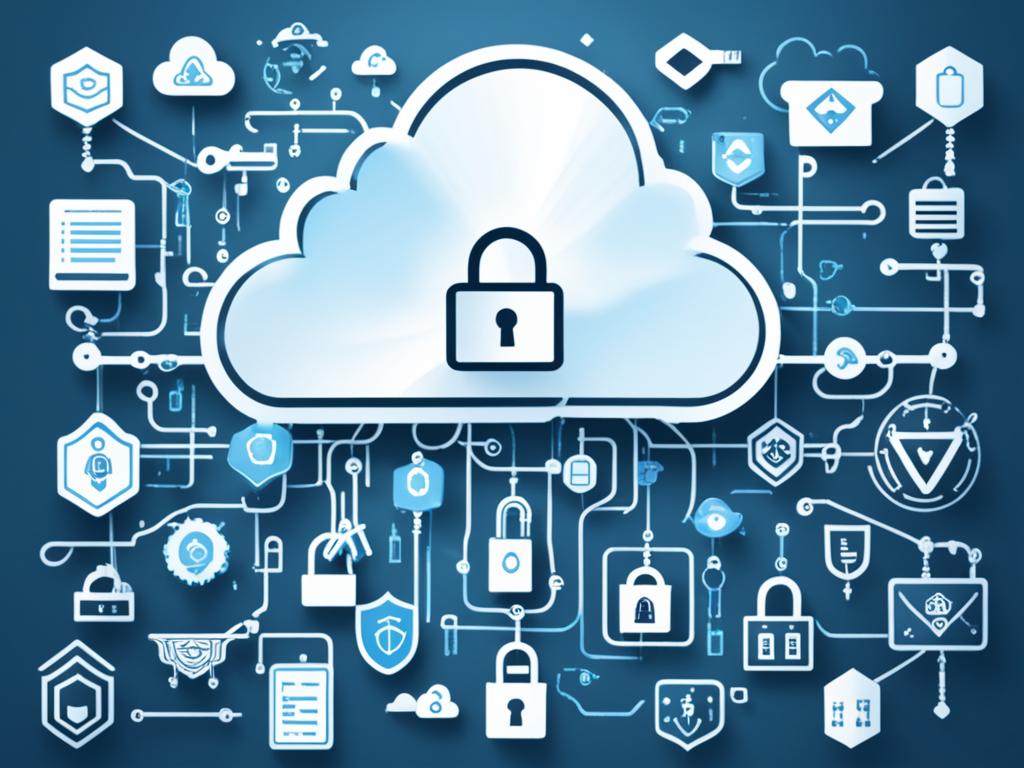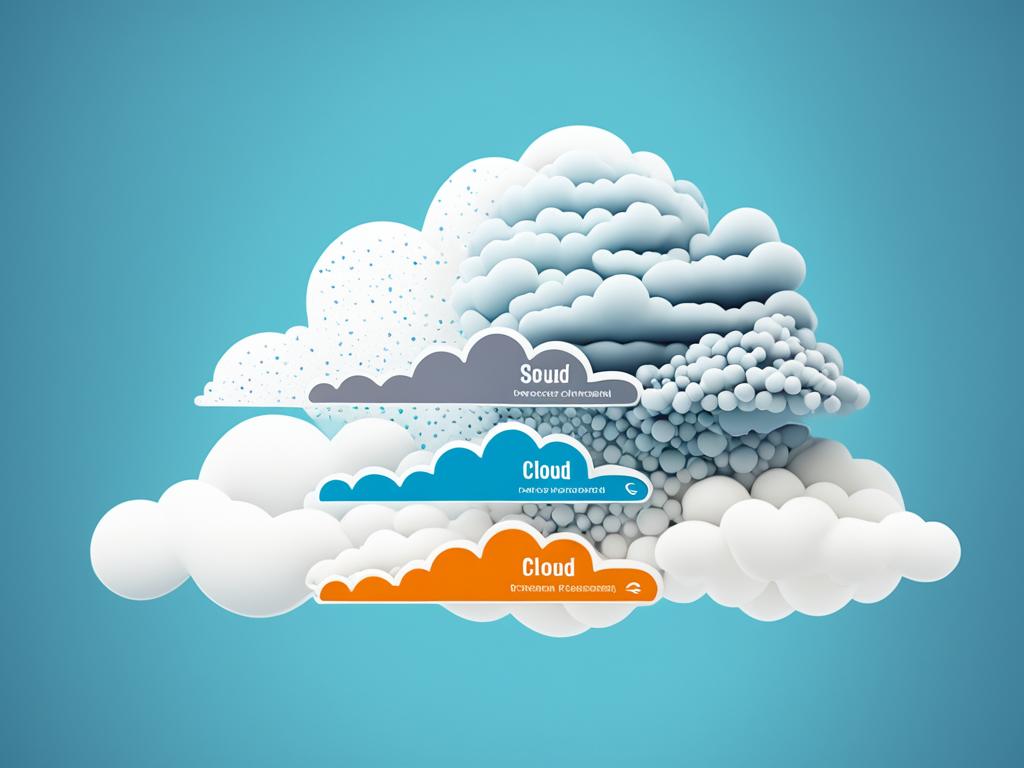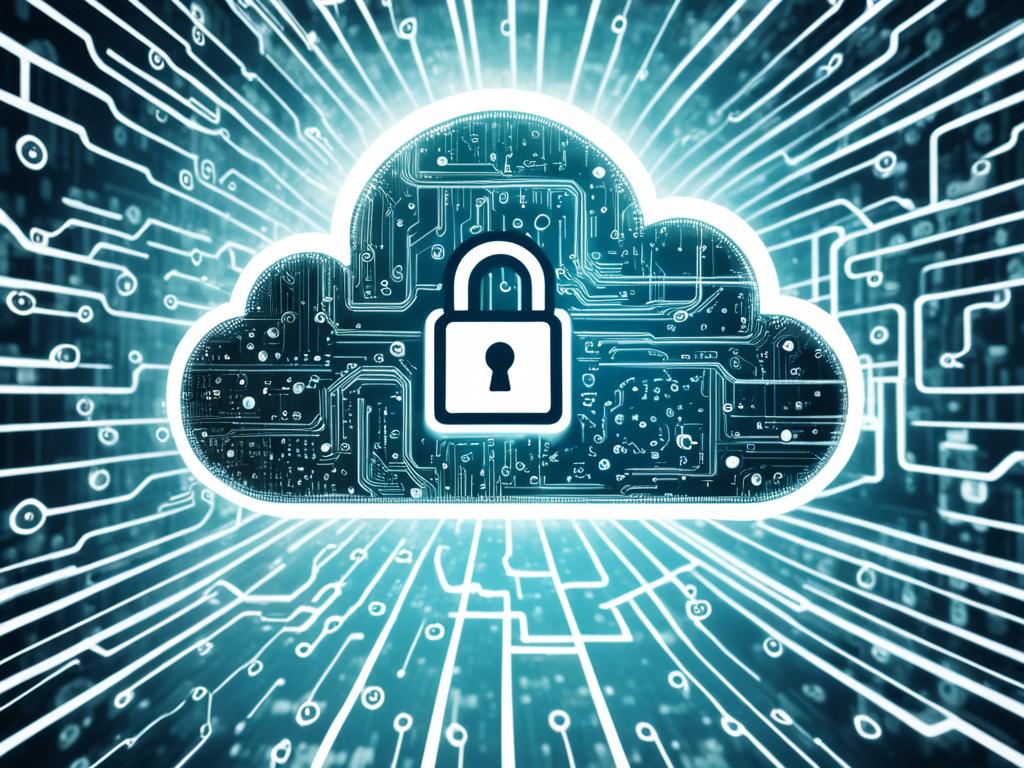Did you know 96 percent of IT pros use the cloud? Cloud use is rising fast, making cloud security key. With more money going into the cloud, companies face many security risks and rules. They must keep their data safe and follow the rules.
This guide will give you the key info for cloud security compliance. We’ll talk about why cloud security is important. We’ll look at cloud service providers and the main compliance rules. By the end, you’ll know how to keep your cloud secure and follow the rules.
Multi-Factor Authentication: MFA is a big deal for cloud security. It requires more than just a username and password. Users must also provide another form of verification, like a code or biometric scan. This makes it tough for hackers to get into your cloud data. When picking a cloud provider, make sure they offer easy-to-use MFA. This should work for all your users.
GDPR Compliance: The GDPR is a key data protection law in the EU. It helps people control their personal data. Cloud storage providers must follow GDPR to serve EU customers. This means they need to handle data access requests, consent, and breach notifications. Choose a cloud provider that has the right certifications and policies. This will help meet your GDPR needs.
HIPAA Compliance: In healthcare, HIPAA is very important. It protects patients’ electronic health information. Cloud providers for healthcare must follow strict security rules. Look for certifications like HITRUST when picking a cloud provider. Make sure they have experience with healthcare organizations. This ensures they meet HIPAA standards.
Key Takeaways
- Cloud computing has become the new normal, with 96% of IT professionals using the cloud.
- Enterprise public cloud spending is expected to grow quickly and significantly.
- Cloud service providers face numerous security threats, including data breaches, system vulnerabilities, and account hijacking.
- Compliance with cloud security regulations is crucial to avoid financial and criminal repercussions, as well as reputational damage.
- Understanding the key cloud security compliance frameworks, such as ISO 27001, SOC 2, and NIST SP 800-53, is essential for effective cloud security management.
Understanding Cloud Security Compliance
What is Cloud Security Compliance?
Cloud security compliance means following rules for cloud service providers and users. It makes sure data, apps, and how they’re used in the cloud are safe and follow the law. It’s like playing “Simon Says” – you must follow the rules or you’re out.
It’s about setting up controls to keep data and systems safe from unauthorized access and breaches. This includes following rules like HIPAA, PCI DSS, and GDPR. Standards like ISO, PCI DSS, HIPAA, and GDPR have clear rules for cloud use.
If you break these rules, you could face fines. Tools like CIS Cloud Security Benchmarks and the Cloud Security Alliance Controls Matrix help make cloud use safe. ISO 27001 helps protect information with best practices, including cloud security.
| Compliance Standard | Focus Area |
|---|---|
| PCI DSS | Securing credit/debit card transactions |
| HIPAA | Protecting electronic health information |
| GDPR | Safeguarding personal data in the EU |
Following these cloud security rules helps keep data and apps safe and available in the cloud.
The Importance of Cloud Security Compliance
More businesses are moving to the cloud. This means they must follow cloud security rules. These rules protect sensitive data and help meet legal standards. They also lower the risk of data breaches.
When moving systems to the cloud, new security issues arise. This is because the cloud uses shared resources and stores data far away. Cloud security rules help set up the right controls and policies. They keep cloud assets safe and show a commitment to keeping data private and secure.
Cloud security compliance has many benefits. It keeps sensitive data safe, like customer info and financial details. This is key for following the law and avoiding big fines or damage to reputation from data breaches.
It also helps reduce business risks. By using strong security measures and following standards, companies can lower the chance of cyber attacks. This keeps operations running smoothly, builds trust with customers, and protects profits. Being seen as trustworthy can give a company an edge in the market.
Cloud security compliance is more than just following rules. It’s a key strategy for companies in the cloud. By using best practices and keeping up with changing rules, businesses can fully benefit from cloud tech. They keep their assets safe and keep their stakeholders’ trust.
| Key Benefits of Cloud Security Compliance |
|---|
| Data protection |
| Regulatory compliance |
| Mitigating business risks |
| Enhancing reputation and trustworthiness |
Cloud Security Compliance: Your Essential Guide
Navigating cloud security compliance can seem tough. But, this guide will give you the key info to get and keep cloud security right. It covers the cloud security compliance guide. You’ll learn why cloud security matters, how cloud providers work, and what tools help meet compliance goals.
Cloud security is key today. It keeps your organization safe and builds trust with customers. This guide will show you how to follow best practices and strategies. It helps you set up a strong cloud compliance framework that fits your industry’s rules.
This guide is for IT pros and cloud beginners alike. It gives you the knowledge and tools to handle cloud security compliance. By using this advice, your organization can protect its cloud assets, meet laws, and stay up-to-date in the digital world.
| Key Cloud Compliance Standards | Description |
|---|---|
| Cloud Security Alliance (CSA) Cloud Controls Matrix (CCM) | A comprehensive framework that provides guidance on security, risk, and compliance for cloud computing. |
| International Organization for Standardization (ISO) 27001 | An internationally recognized standard that provides requirements for establishing, implementing, maintaining, and continually improving an information security management system. |
| National Institute of Standards and Technology (NIST) Special Publication 800-53 | A comprehensive catalog of security and privacy controls for federal information systems and organizations, which can also be applied to cloud environments. |

Knowing these cloud compliance standards helps you protect your cloud assets. It prepares your organization for changing laws and keeps your cloud safe.
Cloud Service Providers and Compliance
The Role of Cloud Service Providers
Cloud service providers (CSPs) are key to cloud compliance. They offer many security features like data encryption and identity management. These help organizations meet compliance needs.
CSPs also get checked by others to show they follow the rules. They give proof of this to their customers.
Big names like AWS, Azure, and Google Cloud have special teams to show they’re secure. With their help, businesses can make sure their cloud use is secure. This lets companies focus more on their main work.
| Cloud Service Provider | Cloud Security Features | Cloud Compliance Certifications |
|---|---|---|
| Amazon Web Services (AWS) |
|
|
| Microsoft Azure |
|
|
| Google Cloud Platform |
|
|
Using the strong security and compliance from top cloud service providers helps organizations improve their cloud compliance. It also lowers the risks of cloud security. These providers are trusted partners in the complex world of cloud compliance certifications.
Achieving Cloud Compliance
Ensuring cloud compliance is a big task for companies today. It starts with a strong cloud security governance plan. This plan is set by top leaders to reduce security risks. Then, security teams work hard to check and manage cloud security risks.
They create detailed cloud security policies and put in place cloud security controls. These steps help keep cloud systems and data safe.
Regular checks for weaknesses, strong login systems, encrypting data, and watching for odd system actions are key. Using tools from cloud providers like AWS Security Hub, Microsoft Defender for Cloud, and Google Cloud Security Command Center helps too. These tools help check if a company meets cloud compliance rules.
| Compliance Framework | Key Requirements |
|---|---|
| GDPR | Strict rules on data protection and privacy for businesses using cloud services in the European Union. Fines can reach up to €20 million or 4% of annual global turnover for noncompliance. |
| NIST SP 800-53 | Comprehensive approach to managing cybersecurity risks for federal agencies and private sector organizations in the United States. |
| FedRAMP | Security assessment and continuous monitoring standards for cloud products and services used by U.S. federal agencies. |
Keeping up with cloud compliance is a constant effort. It needs good planning, strong governance, and knowing the rules well. By focusing on cloud security and following the rules, companies can lower risks. They also build trust with customers and get ahead in the cloud market.
Common Cloud Compliance Frameworks
Cloud security compliance can be tough, but knowing key frameworks helps. The Cloud Security Alliance (CSA) Cloud Controls Matrix (CCM), ISO 27001, and NIST SP 800-53 are top frameworks. They guide how to keep cloud data safe and follow the law.
Cloud Security Alliance (CSA) Cloud Controls Matrix (CCM)
The CSA CCM gives clear rules for checking cloud security. It looks at 17 areas, like data safety and user access. This makes it easy to follow many laws and keep cloud data safe.
International Organization for Standardization (ISO) 27001
ISO 27001 is a global standard for keeping information safe. It helps organizations manage their security well. It covers many areas, from keeping data safe to protecting assets.
National Institute of Standards and Technology (NIST) Special Publication 800-53
NIST SP 800-53 is from the U.S. government. It lists security rules and advice. It helps with things like risk management and handling security issues.
These frameworks are key for keeping cloud data safe and following the law. It’s important for companies to use them right to stay secure and follow the rules.

Cloud Security Compliance Standards
More businesses are using cloud computing. That’s why it’s key to follow strong cloud security standards. These standards help protect data and apps in the cloud. They make sure organizations meet security needs and follow the law.
The ISO 27001 and ISO 27017 are big names in cloud security. They give rules for keeping data safe and managing risks. They help protect cloud assets.
The PCI DSS is important for businesses that handle credit card info in the cloud. It sets strict security rules. This keeps payment card info safe and follows the law.
In healthcare, the HIPAA is key for protecting patient data in the cloud. It’s vital for keeping healthcare info safe and private.
The GDPR is a big deal for protecting data in the EU. It makes sure data is handled safely and with privacy in mind. It builds trust and openness.
| Standard | Key Focus | Applicability |
|---|---|---|
| ISO 27001 and ISO 27017 | Comprehensive security controls for cloud environments | Globally recognized cloud security standard |
| PCI DSS | Securing credit card data in cloud-based transactions | Mandatory for businesses handling credit card payments |
| HIPAA | Protecting patient data in healthcare cloud services | Required for healthcare entities storing or processing PHI |
| GDPR | Ensuring data protection and privacy for EU citizens | Applicable to businesses operating in the EU or handling EU data |
Following these cloud security standards shows a company cares about protecting digital assets. It builds trust in cloud services. It also makes sure companies meet laws in their field and area.
Tools for Cloud Security Compliance
In the fast-changing cloud world, tools like Cloud Security Posture Management (CSPM) and Cloud Workload Protection Platform (CWPP) are key. They help keep cloud security up to date. These tools check cloud resources as they change, spot mistakes, and fix security risks.
Cloud Security Posture Management (CSPM)
CSPM tools let companies watch their cloud setups and find security and compliance problems. They look at cloud stuff, services, and settings to see if they follow the rules. This helps fix security and compliance issues before they get worse.
Cloud Workload Protection Platform (CWPP)
CWPP tools make sure cloud workloads are safe and follow the rules. They keep an eye on cloud stuff like virtual machines, containers, and serverless functions. This makes sure they meet the rules and standards.
CSPM and CWPP tools are very important for keeping cloud security up to date. They help companies deal with the cloud’s challenges. They make sure cloud resources are safe, private, and always there when needed.
| Cloud Security Tool | Key Features | Benefits |
|---|---|---|
| Cloud Security Posture Management (CSPM) |
|
|
| Cloud Workload Protection Platform (CWPP) |
|
|
Conclusion
Thinking about cloud security compliance makes me realize how key it is. It protects our data and keeps us in line with the law. With more companies using the cloud, it’s vital to make sure our cloud setups are safe and follow the rules.
Knowing about different compliance rules like GDPR, HIPAA, and PCI DSS helps. It lets companies make sure their cloud security matches their industry’s needs. Using cloud service providers’ security tools and knowledge is also a big help in following cloud rules.
Putting cloud security first is more than just following the law. It’s about being responsible with data and earning trust from customers and others. By sticking to the best cloud security practices and setting up the right controls, companies can move safely in the changing cloud world. This way, they keep their data and systems secure, private, and in line with the law.
Source Links
- https://www.smartsheet.com/content/cloud-security – Essential Guide to Cloud Security: Risks, Standards, Policies, and Best Practices
- https://cyscale.com/blog/cloud-security-and-compliance/ – Cloud Security and Compliance: A Guide for Your Cloud Infrastructure
- https://cloudsecurityalliance.org/blog/2024/03/29/security-compliance-for-cloud-services – Security Compliance for Cloud Services | CSA
- https://www.exabeam.com/explainers/cloud-security/cloud-security-standards-iso-pci-gdpr-and-your-cloud/ – Cloud Security Standards: ISO, PCI, GDPR and Your Cloud
- https://docs.aws.amazon.com/whitepapers/latest/aws-overview/security-and-compliance.html – Security and compliance – Overview of Amazon Web Services
- https://www.centraleyes.com/glossary/cloud-security-compliance/ – What is Cloud Security Compliance ? Why its Important ?
- https://www.lookout.com/blog/cloud-security-compliance – Cloud Security Compliance: Ensuring Data Safety in the Cloud
- https://oit.utk.edu/security/learning-library/article-archive/safeguard-your-data-in-the-cloud/ – Safeguarding Your Data in the Cloud: A Guide to Cloud Security
- https://knowledge.cloudsecurityalliance.org/certificate-of-cloud-security-knowledge-v5 – Certificate of Cloud Security Knowledge v5
- https://public.cyber.mil/dccs/ – DoD Cloud Computing Security – DoD Cyber Exchange
- https://www.crowdstrike.com/cybersecurity-101/cloud-security/cloud-compliance/ – Cloud Compliance: Regulations and Best Practices – CrowdStrike
- https://www.aquasec.com/cloud-native-academy/cloud-compliance/cloud-compliance/ – 8 Cloud Compliance Standards & 7 Steps to Achieving Compliance
- https://www.digitalocean.com/resources/articles/cloud-compliance – Understanding Cloud Compliance For Data Security and Privacy | DigitalOcean
- https://spot.io/resources/cloud-security/cloud-security-compliance/ – Cloud Security Compliance: 5 Frameworks and 4 Best Practices | Spot.io
- https://www.pluralsight.com/resources/blog/cloud/compliance-frameworks-for-cloud-security – 7 compliance frameworks your cloud team needs to know
- https://cloudsecurityalliance.org/blog/2021/10/21/cloud-compliance-frameworks-what-you-need-to-know – Cloud Compliance Frameworks: What You Need to Know | CSA
- https://www.aquasec.com/cloud-native-academy/cspm/cloud-security-standards/ – 10 Cloud Security Standards You Must Know About – Aqua
- https://www.sentinelone.com/cybersecurity-101/cloud-security/cloud-security-standards/ – Cloud Security Standards: Top 12 Standards
- https://www.hyperglance.com/blog/cloud-compliance-standards/ – Cloud Compliance & Security Standards
- https://aws.amazon.com/products/security/ – Cloud Security, Identity, and Compliance Products – Amazon Web Services (AWS)
- https://www.oracle.com/corporate/cloud-compliance/ – Cloud Compliance with Oracle
- https://snyk.io/series/cloud-compliance/compliance-tools/ – Cloud Compliance Tools Guide – Capabilities & Techniques | Snyk
- https://www.securekloud.com/blog/cloud-security/ – Understanding Cloud Security: What It Is and How It Works | SecureKloud
- https://www.tufin.com/blog/cloud-security-compliance-critical – Cloud Security Compliance: What is it and why is it so critical? | Tufin
- https://www.confiz.com/blog/cloud-security-compliance-and-best-practices/ – Cloud security compliance: Frameworks, challenges and best practices
